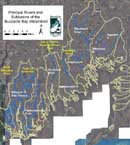Managing Drinking Water Withdrawals to Protect Rivers and Wetlands
Sub-pages: Mattapoisett River Valley | Paskamansett River
Water Withdrawal Issues
As growth in the Buzzards Bay watershed has increased in recent decades, both the quantity and quality of public water supplies have been threatened. In some cases, both public and private water withdrawals are cumulatively affecting wetlands, anadromous fish runs, and other wildlife habitat, particularly during droughts. Buzzards Bay’s growing population is creating a need for additional water supplies, but available land to develop future water supplies is disappearing because of the intensity of land use and the loss of open space.
Perhaps the greatest water management issue in Buzzards Bay is that much of the public, and even some municipal officials do not understand where their water comes from, what pollution threats may threaten their water supply, nor how unmanaged water withdrawals from groundwater and surface water may affect wetlands and river habitat. A surprisingly common misconception among some is that groundwater comes from distance sources (like the mountains of New Hampshire) via deep underground rivers. This is incorrect; all surface water and groundwater in the Buzzards Bay watershed is derived from rain and snow that falls on the Buzzards Bay watershed. Another misconception is that groundwater withdrawals are vast or unlimited or do not affect water levels in ponds and rivers. This is also incorrect. Water groundwater withdrawals can lower water levels in rivers, ponds and other wetlands.
Of the eight major river subwatersheds on the western shore (the Westport River, Paskamanset River, Acushnet River, Mattapoisett River, Sippican River, Weweantic River, Wankinco River, and Agawam River), two river systems have been identified as becoming potentially stressed by water withdrawals during drought conditions. These two vulnerable watersheds are the Mattapoisett River and Paskamansett Rivers. In both these river systems, water withdrawals are relatively large compared to groundwater recharge rates, particularly during the summer.
All water withdrawals within the Buzzards Bay watershed, whether from large volume wells or numerous small volume wells, affect the overall water budget of the watershed. Likewise, all withdrawals within river basin subwatersheds affect the water budgets of those subwatersheds. The consumptive portion of water withdrawals (that which is evaporated, transpired by irrigated vegetation, conveyed as stormwater runoff, or transported out of basin and not returned through wastewater discharges or infiltration of excess irrigation water) represents a cumulative loss of the overall water available within the watershed or subwatershed to sustain water resources and their associated flora and fauna. Whether these withdrawals and transfers have impacts that must be addressed by management action depends on a number of factors.

Major Buzzards Bay rivers and their subwatersheds. View a larger map.
Low River Flow Periods
Whether or not there are drought conditions, generally September and October are the months with the deepest groundwater and lowest river flow. Low flow and deep groundwater occurs because of continued consumption and transpiration of plants through the summer, continued high summer use because of lawn irrigation and agriculture use, and because July, August, and September are our driest months. A drought during this period, coupled with high water withdrawals from wells can result in the drying of wetlands and river beds. Both the 1999 and 2007 dry river occurrences in the Mattapoisett River occurred in September and October respectively.
Historically, the periods of highest water consumption in most towns occur in July because of the influx of summer residents, tourists, and frequent lawn irrigation. However in July, water levels tend to still be high from Spring Rains
Groundwater and surface Water Data
USGS’ Massachusetts Climate Response Network page
Great site, just click on the map to obtain historical average groundwater elevations for long term monitoring well sites.
USGS Surface Water Levels Data retrieval page for Massachusetts
Groundwater Levels: Historic and Recent for two sites
The graphs below for two wells, one in Duxbury (continuous monitoring), and one in Wareham (monthly reporting) will give you a sense as to how recent rainfall may be affecting groundwater in our region. Red Line shows actual levels for this past year (live link from USGS) versus historic levels (colored interval bands and historic monthly means).

Stream Flow
USGS’ Water watch page
Click on the map to obtain real time stream monitoring data.
USGS’ Paskamanset River, Dartmouth, MA Real Time page
More information on precipitation and drought is on the BBNEP’s Climate page.
Links
River Instream Flow Stewards (RIFLS) program
Low Flow Inventory for Buzzards Bay
EEA Report: Stressed Basins In MA
Ipswich River Watershed Association
A North Shore group grappling with low river flows.

